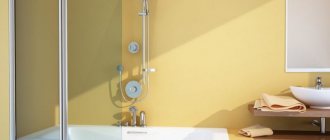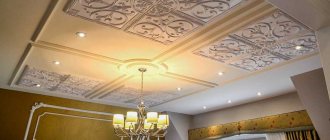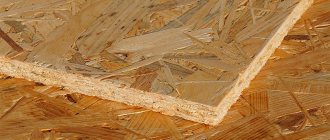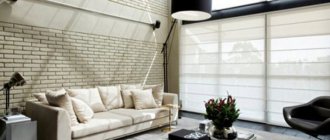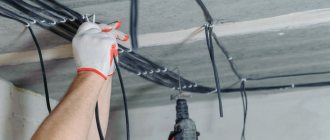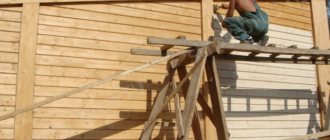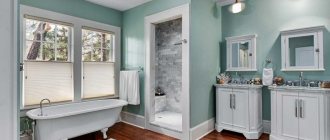Applying paint to the ceiling as a finishing coat is the most common finishing method. And even today, despite the large selection of different materials and solutions, paint continues to be popular. Advantages: ease of use, large assortment, wide color palette, versatility, budget cost. But how can you buy the right option from such a variety? What and how to paint the ceiling so that it will please you with its appearance for a long time?
General provisions
Any paint is classified according to the type of material, gloss and washability. Depending on the reflective properties of the surface, painting materials can be glossy or matte. Glossy painted ceilings are characterized by the presence of shine and high decorative characteristics. However, to apply such a coating it is necessary to carry out careful preparatory work to eliminate the slightest irregularities and defects.
As for matte paint, due to its lower reflectivity, it is able to mask minor flaws in the base base. This reduces the time and effort required for plastering or putty by an order of magnitude. An intermediate option is also available for sale - the so-called. “semi-gloss” paints: they are able to impart a certain shine to the ceiling surface, simultaneously masking minor defects and irregularities.
Depending on their ability to withstand wet cleaning, paints are either washable or non-washable. The selection of a specific option depends on the operating conditions. For rooms with a low level of pollution (bedrooms, children's rooms, living rooms), inexpensive non-washable options are quite suitable. It is better to paint a kitchen, hallway or bathroom with a washable material that can withstand regular wet cleaning with a sponge, rag and detergents without loss of decorative characteristics.
How to clean the base of an old coating
- Methods for removing old whitewash: cleaning the ceiling before painting
Cleaning the ceiling is one of the stages of preparation...To watch photos "
This is a dirty and unpleasant stage of work. Before leveling the surface for painting, it must be cleaned down to the concrete base. For this work you will need a strong metal scraper (an old spatula can be used), a sharp hatchet and a brush. When cleaning, it is advisable to protect your hands with gloves and your respiratory organs with a respirator. Work must be carried out from scaffolding of a suitable height (so that your head does not rest, you can freely reach the ceiling).
The technology for implementing the process depends on what exactly needs to be removed:
- Wallpaper. It’s easiest with old wallpaper - they are usually removed immediately, or after pre-wetting;
- Whitewash. The same can be said about whitewashing: although a lot of dirt arises when cleaning it, this procedure generally does not encounter any particular difficulties. The whitewash is first soaked in warm water, then cleaned off with a sharp scraper.
- Dye. The most inconvenient type of finish to clean, as it does not get wet from water. Only diligence, a scraper or a sharp hatchet will help here. Although there are recommendations for the use of special liquids for removing paint, however, due to the toxicity inside the home, it is better not to use them.
- Putty. Old putty exists under any of the above finishes and must also be removed. Sometimes it seems that the old putty layer is very strong and can be left. But such a solution is accompanied by the risk of swelling (often at the last stage of repairing the ceiling, during its painting).
- Frame systems, panels. Here, dismantling is the easiest, since it is not accompanied by the appearance of dirt.
To make the work faster, it is recommended to sharpen the scraper from time to time using sandpaper.
When cleaning the concrete surface, all discovered seams and cracks deserve special attention. They must be carefully opened, removing all the solution inside.
Features of water-based paints
The main option for painting the ceiling in an apartment is water-based compositions. In another way they are also called water-dispersed. Plain water is used as a solvent here. Among the ingredients there are also film-forming materials - pigments that impart covering properties to the substance. To give the paint the necessary performance properties, special additives are introduced into its composition.
The result is a liquid suspension consisting of solid components (base, pigments and additives) suspended in the liquid. A very important point is that these particles do not dissolve and do not mix with water. As a result of application to the base to be decorated, water evaporates, after which only the polymer layer of the desired color remains.
Water-dispersed paints have a number of strengths, which makes it possible to decorate not only ceilings, but also walls indoors for various purposes:
- High adhesion
. This allows the material to fit well on almost any base, forming a reliable “adhesion” with it. If the surface preparation technology is carried out correctly, there is no need to worry about peeling or swelling in the future. - High drying speed
. Usually after 2-3 hours the painted surface can be used. - No unpleasant smell
. This makes the work much easier, because... there is no need to use personal respiratory protection. This is especially appreciated when finishing large areas. The absence of harmful toxins makes the material environmentally friendly. It can be used without restrictions in any room. - Easy to apply
. Working with water-based paint usually does not cause difficulties even for a person without painting experience.
Compositions of this type also have some disadvantages:
- Temperature requirements
. Water-dispersed paints must not be used in unheated rooms where the air temperature can drop below +5 degrees. Otherwise, small cracks will appear on the finishing surface. - Humidity restrictions
. If the humidity level in the room is high, then water-based paint simply will not be able to dry: the water in its composition will have nowhere to evaporate. - Requirements for the quality of foundation preparation
. It needs to be well leveled and sanded, because... Painting this type of slope will further highlight any imperfections in the surface.
Water-based paints are acrylic, silicate, silicone, mineral and polyvinyl acetate.
Types of putty
When choosing a putty for painting, you need to know that it is not advisable to use a universal putty, since it contains fractions of a fairly large size, and the surface after drying will become rough, and it cannot be cleaned even with a fine-grained grater.
To obtain a smooth surface, purchase starting and finishing putties from the same manufacturer. In this case, they match each other in composition and there is no chance of exfoliation from the base.
To putty the ceiling, it is recommended to purchase starting and finishing putties from the same manufacturer.
Choose a putty taking into account where the finishing work will be done:
- in a dry room;
- in the toilet or bathroom;
- in the kitchen;
- veranda, loggia and other semi-open spaces.
The choice of finishing material also depends on how much the surface will be exposed to moisture.
When purchasing a composition, they use the services of a consultant. If the seller is inexperienced, then you can follow the tips:
- The packaging of the putty for use in a dry room is marked KR, for rooms with high humidity - LR+;
- you need the same amount of starting putty as finishing putty;
- purchase either putty marked “for any surfaces”, or special ones for concrete, drywall, and wooden surfaces;
- Ready-made mixtures are available for sale in buckets of different capacities and dry, packaged in bags of 15, 20 kg.
There are several types of putty for rooms with different humidity levels
It is more convenient for a novice master to use already prepared mixtures, but there is one catch - after unpacking, they are used within the period specified in the instructions.
Gypsum putty has a very short shelf life (4-6 hours). If you are not sure that the composition will disperse quickly, buy dry putty in bags and dilute as much as you see necessary.
Inexpensive mixtures are selected based on composition until the skill appears:
- with PVA glue;
- gypsum;
- adhesive and oil-adhesive.
It should be taken into account that oil-glue putty, although inexpensive, is dense in consistency and difficult to spread, gypsum putty sets quickly, and the mixture with PVA glue cannot be applied in a thick layer, as there is a possibility that it will “float”.
PVA putty
Gypsum putty
Oil-adhesive putty
After you get your hands full, they work with water-dispersion, latex and acrylic mixtures. Although they are expensive, working with them is a pleasure thanks to their characteristics:
- have excellent adhesion;
- easy to apply and spread on the surface in a thin layer;
- have a boiling white color;
- after drying, they become dense, do not scratch, and are easy to sand;
- after sanding the ceiling becomes smooth;
- treated surfaces last a long time.
Kneading is done in small portions.
You can choose either a Russian or foreign manufacturer. Each company adds additives that make their products unique.
The Russian ones that are in demand are “Prospectors”, “Osnovit Ekonsilk”, “Rusean TT”. Foreign ones are more expensive, but experienced builders prefer Sheetrock, Knauf, Ceresit, Bergauf, Weber LR+.
Putty "Volma"
Putty Prospectors
Putty Osnovit Ekonsilk
Putty Rusean TT
Sheetrock putty
Putty Knauf
Ceresit putty
Bergauf putty
Weber LR putty
Acrylic paints for ceilings
Compositions of this type are made on the basis of acrylic resins: it is they, together with various additives, that form a decorative film on the surface of the ceiling. Among other options for painting the ceiling in a room, acrylic paint is the most popular. With its help you can decorate concrete, wood, polymer, steel, glass and plaster bases. The material dries very quickly, without emitting unpleasant odors or toxic substances.
Acrylic compounds are known for their durability. Once applied to the ceiling, they can last a long time without losing their decorative qualities. Such a surface is not afraid of sunlight, abrasion, peeling and crumbling. The created layer of paint allows steam to pass through, which is very convenient when decorating rooms with high humidity levels. The high adhesion of the material should be taken into account: once applied, it will not be easy to remove. Therefore, you need to decide in advance for what time this finishing is designed. In the process of preparing the base, it is recommended to use special antiseptic impregnations.
A special type of acrylic paint stands out - acrylate. Along with the standard set of components, latex was introduced into its composition. This makes it possible to impart additional unpretentiousness and durability to the material. Acrylate compounds adhere very well and adhere to the surface, masking various minor flaws in the form of cracks, crevices and base defects.
To enhance this effect, it is recommended to apply the material in two layers. In the future, the finished finish can be washed using delicate detergents. According to the manufacturers of acrylate paints, the base decorated with their help is able to withstand many washing cycles, with full preservation of the original decorative characteristics. The high performance characteristics of acrylate paints are expressed in the fairly high cost of this type of material.
Which paint manufacturer should you prefer?
Some of the most famous brands included in the top ten include:
- Dufa. Founded in 1947, this brand from Germany continues to hold a leading position among global manufacturers.
The company's products are manufactured using modern equipment and meet all safety requirements. A wide range of specialized water-based compositions will allow you to choose the best option for finishing ceilings;
- Caparol is another German brand represented by the DAW SE group of companies, which supply their products throughout Europe. Their product occupies a leading position among representatives of professional construction. The Caparol brand is distinguished by high quality and respect for the environment. The main advantages of its coloring compositions are resistance to abrasion and washing, therefore they are most often preferred for finishing premises in public buildings, where large flows of people pass daily;
- Dulux is an English brand whose paints have the following advantages:
– medium viscosity, the composition lies on the surface easily and evenly;
– deep matte color, eliminating all visible flaws on the ceiling surface;
– moisture resistance;
– dries quickly.
Dulux brand paints are available in compositions with any texture; they can be used to paint ceilings in children's rooms and bedrooms;
- Tikkurila has been producing high-quality paints for painting various types of surfaces for more than 130 years. The brand is popular in more than 40 countries around the world and offers consumers tinted paint that can help realize any design idea.
Despite the large number of competitors, Tikkurila brand ceiling paint still occupies a leading position and is in the top ten.
Silicate
The basis of silicate paint is a mixture of liquid glass, talc and chalk. After application, a very hard and durable coating is formed on the surface, the service life of which reaches 15-20 years, even in the presence of unfavorable external conditions. Indoors, where there is virtually no aggressive impact on the finish, silicate paints can last an order of magnitude longer.
An important advantage of this finishing material is its high vapor permeability. As a result, water molecules can circulate freely in any direction, providing a microclimate that is favorable for humans indoors. In addition, the decorative layer will not peel off or become damp. It is still not recommended to use silicate paints in very damp rooms. But when choosing which paint is best to paint the ceiling in a room for water procedures or cooking, you need to pay special attention to silicate paints.
However, the specificity of liquid glass is such that due to its low elasticity, silicate paint is prone to cracking. This must be taken into account when looking for an option on what paint to paint the ceiling in an apartment in houses where walls and ceilings tend to shrink. Before applying this type of material, it is necessary to very carefully remove all traces of previous paint from the base (primarily this applies to organic finishes). In terms of moisture resistance, silicate paint is very similar to acrylate paint: it can be washed with a damp sponge and household chemicals.
How to calculate the required quantity
To paint, you need to buy the required amount of paint, so before going to the store you should calculate the area of the surface to be treated. Each manufacturer indicates the average material consumption on the packaging; accordingly, the available area must be multiplied with the consumption indicator. It is necessary to take into account the number of layers applied; each new layer will require applying less paint.
To make calculations easier, manufacturers have a consumption calculator on their website. In the special windows you need to enter the parameters of the room to be painted.
It is necessary to take into account the number of layers applied; each new layer will require applying less paint.
Ceiling paint is a good option to finish it. If you carefully prepare it for painting, then applying paint will not be difficult. The construction market presents a large number of products that can create durable coatings. In order not to make a mistake with the choice, take into account the parameters of the room and focus on the criteria described above.
Silicone ceiling paints
This type of paint became freely available relatively recently. Silicone resins are used as the main binder here. As a result, the resulting composition managed to combine two very unusual characteristics - hydrophobicity and vapor permeability. After drying, the decorative layer created on the ceiling will allow moisture vapor to pass through well, without causing the formation of a damp, stuffy atmosphere. In this case, excess moisture will not affect the ceiling material or thermal insulation.
Silicone compounds are superior to their silicate counterparts in terms of elasticity. At the same time, the finish continues to be durable and resistant to ultraviolet radiation. The good elasticity of the film formed on the ceiling allows you to protect the finish from the appearance of cracks in the event of shrinkage processes. In addition, the material smoothes out small cracks or defects in the base well, filling them flush with the surface. Silicone paint fits perfectly over the old finishing layer. The ceiling finished in this way can be periodically repainted, refreshing or changing the color of the finish.
Like other types of water-based paints, this material demonstrates excellent characteristics in terms of durability, environmental safety, fire resistance, antiseptic characteristics, drying speed and the complete absence of unpleasant odor. Among the disadvantages of silicone paints, one can highlight their high cost, which imposes additional responsibility on calculating the required amount of material.
Leveling the ceiling with plasterboard
Due to the fact that installation of plasterboard structures can be done without special training and experience, this material is so often used by designers to realize their most extraordinary ideas. And also with the help of plasterboard you can easily and quickly level the ceiling for painting.
- Methods for leveling the ceiling for touch-up using plasterboard.
The plasterboard frame allows you to create a perfectly flat ceiling surface. Let's consider 2 commonly used methods of constructing a frame: rigid and free.
Rigid fixation - sheets of plasterboard are attached to the ceiling, wall profile, and around the perimeter of the room. It is recommended to install the structure in this way in those apartments or houses where shrinkage has already occurred.
If the house is located on heaving ground, or the ceiling is planned to be leveled for painting in a new building, it is best to use free installation of a plasterboard structure. This is explained by the fact that the dynamic stress will decrease if there is no adhesion to the wall.
- We do the markings correctly.
The quality of the marking determines how smooth the surface will be. Do you have a perfectly horizontal ceiling? Congratulations, the main conditions for correct marking have already been met. Otherwise, you will have to straighten the horizontal surface. What needs to be done for this?
Along the perimeter we measure 2-3 centimeters from the ceiling, fixing the points. We draw a line along the resulting marking. The goal is to match the ends of the line. If the ends of the measuring beam diverge, it means an error was made.
Use a little secret to create benchmarks. Take ordinary thread, dye it blue, then wind it on a spool. After this, pull between the opposite marks. A cord can act as a guide, which must be pulled between the screws along the indicated line.
Also mark the lines on the ceiling. Distribute the direction of the plasterboard sheets. Two reference lines come from a right angle in the opposite direction.
Remember that the quality of preparation for leveling the ceiling for painting directly affects the final result of the entire work.
- Frame.
Fix the perforated plates to the ceiling. Using the holes on the metal hangers, you can set the required height.
After you attach the ceiling profile, the unnecessary part of the suspension should be folded and removed inside the structure.
Make sure that the gap between the hangers is no more than 1.5 meters. Secure the hangers with dowels and screws of the same diameter. Important! Use dowels with caps, as they will not allow the fasteners to “sink” more than necessary. This way, no voids will appear in the ceiling.
The next stage is laying insulating material, wiring and all necessary communications.
Install profiles under the hangers. Using a U-shaped suspension, you can make the frame smoother.
- Secure the drywall.
Drywall should be attached in one direction. Make sure that the screws are attached close to the back of the profile. This way the screw will not bend inward, which means it will not interfere with the connection of other plasterboard sheets.
Stepping back 1 cm from the edge, screw self-tapping screws into the plasterboard sheets. The main condition is the right angle of entry of the self-tapping screw. The acceptable depth of penetration into the profile flange is 1 cm.
After the plasterboard structure has been installed, you can begin to putty the joints. This can be done by gluing the seams with a mounting sickle.
Mineral and polyvinyl acetate
These compositions are made on the basis of cement (slaked lime) and polyvinyl acetate (this is the well-known PVA glue). Mineral paints are usually used to decorate ceilings made of concrete panels: the service life of such a coating is not very long. The scope of use of PVA-based materials is dry rooms, because... The decorative layer created with their help is not hydrophobic.
Preparatory work – puttying or plastering?
Before painting begins, regardless of the ceiling covering, the surface must be prepared. We examine the surface and remove pieces of the old coating. The process may take longer if you need to get rid of a layer of old water-based paint. First, remove loose pieces of coating with a spatula, and then moisten the surface with plenty of water at intervals of 20 minutes. During this time, moisture will saturate the old layer. To speed up the process, open windows and doors, creating a draft. The paint will begin to swell and can be easily removed with a spatula. We wipe away any stains and rust that have formed with a fungicidal solution.
Before painting the ceiling must be leveled
Next, using a level, we check the differences, study the unevenness and cracks in the ceiling. Differences of up to 2 mm are leveled with putty, and more with a plaster mixture. We fill small cracks with putty, if necessary, widen them and fill them. Apply the leveling mixture using a spatula, leveling it evenly over the surface. It is especially important to create an even, blemish-free finish when using glossy paint.
After applying the putty or plaster mixture, let the surface dry completely and begin sanding. To do this, we use fine-grained “zero” sandpaper. Remove any remaining dust from the surface using a brush, broom or vacuum cleaner. The prepared surface must be completely dry, free of dust, to create maximum adhesion to the primer and paint.
Oil and enamels
Along with water-based compositions, ceilings are sometimes decorated with oil paints and alkyd enamels. In the first of them, the role of a binding component is played by organic oil or drying oil. The latter contain alkyd varnishes and organic solvents. It should be said that materials of this type are gradually being forced out of the market for compositions for painting ceilings in a room.
The reasons for this process are as follows:
- The ceiling coating created using alkyd enamel is characterized by strength and durability, but during application it is necessary to overcome a number of difficulties. We are talking about long-term drying and the presence of an unpleasant noxious odor. The enamel layer formed after drying does not allow steam to pass through easily, which leads to the effect of blocking the room. As a result, in the bathroom or kitchen this is fraught with condensation on the ceiling.
- Oil paints have even lower performance properties. In addition to slow drying, unpleasant odor and lack of vapor permeability, the resulting finish is fragile and weakly elastic. This often leads to the appearance of cracks on the surface. The only advantage of oil paint is its low cost.
Popular manufacturers
The variety of brands producing ceiling enamels in construction stores is great. The choice of paint depends on the personal preferences of the manufacturer, financial capabilities and the effect to be achieved. Among the popular ones, we highlight 8 manufacturers who have won the trust of users.
Tikkurila
The famous Finnish brand creates high quality finishes. The materials are used when working with problematic surfaces; they work well on putty, drywall and wood. The mixture contains substances with antibacterial properties that prevent the development of dangerous microflora and can be used in the bathroom and kitchen.
Finnish paints Source cmp24.com.ua
Adhesive compositions
These materials also fall into the budget category. They are an aqueous mixture of chalk, pigment and glue.
There is the following recipe for making it yourself:
- Dry mix chalk and pigment in a ratio of 1000:35. It is important to achieve complete homogeneity of the dry mixture.
- Pour water into the dry powder (3 liters of water per 1 kilogram of mixture). It is better to do this gradually, mixing the ingredients well. The result should be a viscous liquid, reminiscent of sour cream in consistency.
- Add glue in a ratio of 80 g of wood glue per 1 kg of chalk. Starch paste can be used as an additive.
- Strain the finished mass through a metal sieve, adding the required amount of water.
It should be understood that the quality of homemade material will be quite low: in this case you cannot count on long-term operation. Still, the best option is to purchase a factory-made version of paint for the ceiling in the room.
Return to contents
The primer composition is part of a set of preparatory measures to strengthen the top layer of the ceiling before painting it. The primer is also a good antiseptic, which limits the spread of any harmful microorganisms.
To apply the solution you need a roller with a long handle, the primer itself and a plastic container.
After completing all preparatory activities, you can begin applying the primer. First you need to pour it into a plastic container, then dip the roller into it, and then carefully squeeze out all the excess. That's all.
This tool is ready to use. You just need to moisten the entire surface of the ceiling with it, and you can consider the task completed. To enhance the effect and reliability, you need to wait until the first layer of primer has dried, after which the treatment can be repeated.
Thus, preparing the ceiling for painting is a simple process, but it requires certain skills and time.
Materials and tools
The quality of finishing the ceiling with paint largely depends on properly prepared tools and materials.
To work you will need the following:
- Roller
. It is the main tool for applying paint to the ceiling. If the area of the ceiling to be finished is small, a lightweight model will do just fine. In other situations, it is recommended to arm yourself with a wide roller, which will require some skill when handling. These tools often come with telescopic extensions that allow finishing work to be done directly from the floor. For applying acrylic and oil paints, foam or plush rollers are more convenient; for synthetic paints, mohair rollers are more convenient. - Set of paint brushes
. They help paint hard-to-reach areas, giving the surface to be decorated a decorated look. The stiffness of the bristles is selected depending on the required thickness of paint application: the higher the stiffness, the thicker the layer.
- Plastic tray
. Paint is poured into it from a can or bucket before application. Such trays have dimensions convenient for soaking the roller and a special rolling surface. - Masking tape
. It allows you to separate sections of the ceiling of different colors or patterns from each other. - Step ladder or sawhorse
. The second option is more convenient. Instead of a sawhorse, you can use an old kitchen table or the already mentioned telescopic extension that fits onto the handle of the roller. - Set of spatulas and scrapers
. They are necessary to prepare the base. - Painting sandpaper
. It is used to treat putty surfaces before painting. - Protective clothing
. Plastering and painting work is accompanied by a lot of dirt, so you should prepare special clothing for the work. These can be old things that can protect your head and body from paint and dust. It is also advisable to purchase safety glasses and a respirator.
General preparation of the room for painting
Before preparing the ceiling for painting, you should take preparatory measures in relation to the entire room being repaired:
- Clear the room of furniture and other interior elements. If for some reason this cannot be done, you must at least cover them with plastic film as protection from dust, paint, etc.
- De-energize the electrical wiring in the room, since during the preparation process you will need to wet the ceiling with water.
Protecting windows from dust and paint
- Window and door openings should also be covered with film, and it is better to temporarily remove the lamps altogether, since it will be difficult to wash them off from chalk splashes.
Advice! It is most convenient to carry out the work in an empty room, the walls of which have not yet been finished (for example, covered with wallpaper), then they will not have to be additionally protected.
Preparing the base
Before painting the ceiling in an apartment with your own hands, it is important to prepare the rough base as thoroughly as possible.
Operating procedure:
- Investigation of the condition of the ceiling
. Determine the scope of future work by visual inspection. On a concrete floor, it is important to notice all the gaps, cracks and joints between the slabs. Wooden ceilings must be sanded and primed, plasterboard ceilings must be sealed. - Cleaning the base from old finish
. The floor slab must be completely cleaned of the previous finish. If it is whitewash, it is washed off with water; if it is old putty or paint, it is removed with a strong spatula. It is advisable to pre-wet the wallpaper and then remove it with a spatula. Any traces of glue found must also be removed. - Priming
. For this, deep penetration impregnation is used to increase adhesion and create a waterproof film. A good option is acrylic primers. - Sealing cracks, joints and cracks
. You will need a starting putty or mortar for laying tiles: the adhesive it contains will make the seam stronger. - Continuous alignment
. If the base is more or less even, you can putty immediately. If there are defects and differences, a leveling layer of the starting mixture is laid. Putty is usually applied in 2-3 layers, which makes it possible to obtain a smooth surface. - Grinding
. The purpose of this procedure is to remove all sagging and small scratches on the putty layer. The tool used is a grater and painting sandpaper No. 120. It is better to protect the respiratory organs with a mask or fabric bandage. - Final priming
. For this, an antiseptic composition is usually used to create protection against mold and mildew.
Sanding and priming
The ceiling is sanded after the starting layer has dried, first with a coarse-grained trowel, then with a fine-grained grater, and the final time - after the finishing putty has dried. The last layer is sanded only with a fine-grained nozzle. They process it very carefully so that the starting application does not show through the bald spots.
After drying, the dried putty surface is sanded with a fine-grained grater.
Ceilings are primed three times: on the original base, on the starting coating and before painting. Priming cannot be neglected, because it guarantees adhesion and protects the surface from mold formation.
Painting the ceiling in the apartment
You can proceed to applying the paint composition only after the ceiling has completely dried:
- Prepare the paint
. This must be done in strict accordance with the instructions on the bucket. As a rule, for the first layer the material is diluted with water in an amount of 10-20%. For convenience, part of the diluted paint is poured into a painting tray that has recesses along the width of the roller. - Application
. It is recommended to start from the corner in the room farthest from the door. First, areas along the ceiling friezes and corners are painted, for which it is better to use a brush. Next comes the roller: after soaking, it must be rolled out to remove excess paint. If this is not done, it will spill onto the floor. It is most convenient to work from a construction sawhorse or an old table. So, step by step, the entire room is gradually painted. - It is recommended to apply the first layer perpendicular to the light
. In places where one area transitions to another, you need to carefully roll out the paint border so that no sagging remains. Each time you move the goat to a new place, you need to inspect the painted area from several angles. If a leak or gap is detected, it must be promptly eliminated before the paint sets. - The second layer is applied only after the first has completely dried
. Usually this takes 3-4 hours, but it’s better to take a longer break. During the second application, the roller should move perpendicular to the direction of the first layer.
How to paint a ceiling with your own hands: preparation for work
First you need to prepare the materials and tools that you will need for your work:
- dye;
- rollers. They are selected taking into account the structure of the surface to be painted. The denser the pile, the better the paint layer will adhere;
- brushes of different sizes for painting hard-to-reach areas;
- container for paint.
Before painting the ceiling, you should carefully prepare the surface. Not all paints require high-quality cleaning of the base, but at a minimum, dust, dirt and loose plaster must be removed. It is also important to seal cracks and screw holes with putty and, if necessary, level the surface. All furniture is first removed from the room, and the remaining interior items, doors and window sills are covered with film.
After completing the preparatory work, you can proceed to the main process.
How to paint - choose a tool
Choosing a paint composition, taking into account the purpose of the room and the base material, is half the battle. Then the question arises, how to properly paint the ceiling so that the surface is pleasing to the eye? The answer is obvious - you need to stock up on tools for applying paints and materials and prepare the surface well. In construction stores, tools are presented for every taste and budget. Our recommendations will help you choose worthy products for high-quality painting.
How to choose a roller
In an apartment or small office space, it is best to paint the ceiling with a roller . It is important to choose a tool with which you can get a good result with the least loss of paintwork materials. When choosing, consider the following points.
1. Roller dimensions (drum and handle size). Drums are from 50 to 250 mm in length, of different diameters, with a proportionally arranged handle from 150 to 500 mm in length. The diameter and length of the drum affect the speed of painting the object. It should be borne in mind that large drums become heavy when the coloring material is collected - only a strong person can paint with them quickly and for a long time. True, when the handle is lengthened, it becomes easier to work with such a roller.
2. What material is the roller made of (velor and foam rollers are not suitable for painting the ceiling - they often have to be dipped into the composition, they form a lot of splashes and leave smudges). To work with water-based paints, tool coats made of: polyamide, polyacrylic, polyester, thread pile, natural six are suitable. The best option for upholstery is sheepskin.
3. Length of the pile (with a short pile, you have to dip the roller into the tray more often; the paint flows down the handle less; with a long pile, more material is held on the tool, which makes it heavier). A roller with medium nap length is best.
4. Density of the fur coat - the denser it is, the better the quality of the paintwork on the base.
5. The presence of a seam. When purchasing a roller, check that the seam is well hidden, as sticking it out will cause unwanted streaks on the surface.
6. Pile strength. Check the quality of the roller - the lint should not fall out, otherwise lint will stick to the ceiling during painting.
How to choose a brush
A brush as a tool for painting ceilings is only suitable for treating areas that are difficult to reach with a roller, as well as for processing the joints of walls and ceilings. Any brush, even a high-quality one, will leave streaks on the surface. However, you need to buy brushes with split bristles, which are elastic and can always return to their place during work.
How to choose a spray gun
Painting the ceiling with a spray gun will provide excellent coverage. Of course, such a result can be obtained provided that the tool is of high quality and the painter has sufficient experience working with it. To carry out the work, there are electric spray guns on sale with a lower tank for paint and with a fence from a bucket. Let’s make a reservation that the latter are not suitable for high-quality painting in an apartment. The bucket intake does not provide a uniform stream of material.
Electric spray guns with a bottom tank do not have this drawback, but they often have to be filled with a new portion of material, and this puts forward new requirements for the uniformity of the paint composition.
When choosing a spray gun, it is necessary to take into account the following points: it is preferable to buy the body of the product from an alloy of aluminum and nickel, the nozzle from brass, and the sealing gaskets from Teflon. A high-quality spray gun cannot be cheap. There are also inexpensive products on sale, but it is not recommended to buy them for the intended purpose.
